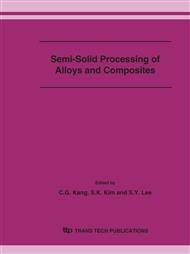p.546
p.550
p.554
p.558
p.565
p.569
p.573
p.578
p.583
Rheological Behaviour and Microstructural Evolution of Semi-Solid A356 Alloy Produced by Different Routes
Abstract:
Different techniques used to produce semi-solid alloys can result in different structures in the material and, therefore, in distinct rheological behaviours which determine its thixo-forming ability. Suitable raw materials to be used for SSM forming must present non-dendritic, very fine or fragmented structure in order to globularize without excessive agglomeration when re-heated to the semi-solid state. This work analyses the influence of raw material production route on the rheological behaviour of semi-solid A356 alloy. Techniques used were: electromagnetic stirring (EMS) and chemical ultra-refining (UR). Samples were re-heated to 580oC (~ 0.45 solid fraction) and hold for 0, 90 and 210s to allow the observation of the structure evolution. After structures characterization, the samples were submitted to compression tests, at δH/δt = 10mm/s, in the same temperature/holding time conditions. Viscosity of the differently prepared raw material was related to the grain size, primary particle size, geometrical factor (roundness shape factor and contiguity).
Info:
Periodical:
Pages:
565-568
Citation:
Online since:
October 2006
Authors:
Price:
Сopyright:
© 2006 Trans Tech Publications Ltd. All Rights Reserved
Share:
Citation:


